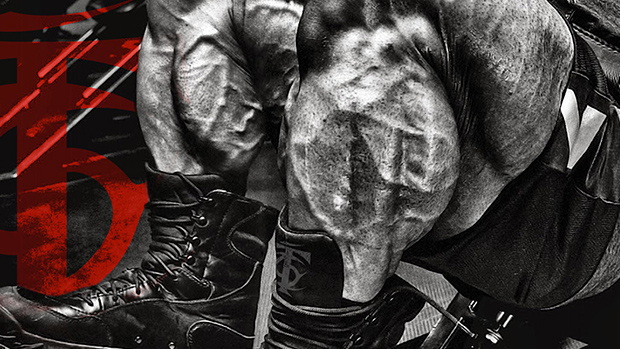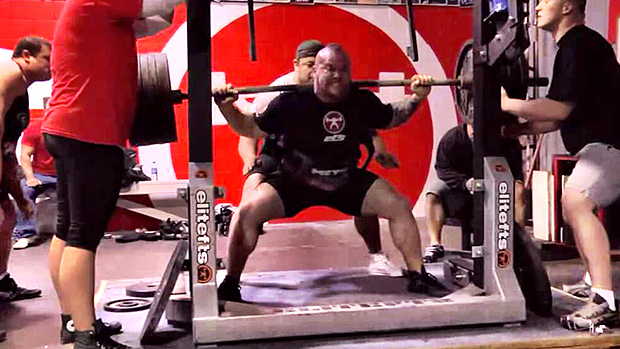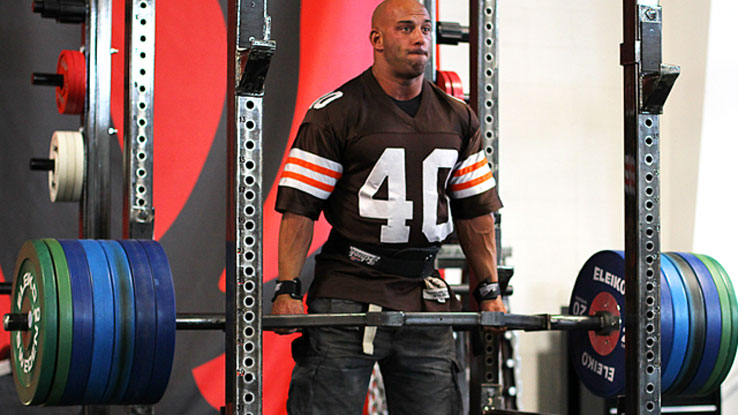The Question
What's your very best tip for building stubborn calves?
Increase their trainability
Calves have three things that reduce their "trainability" or their potential to improve:
- A very short range of motion, which means each rep has a very short time under tension.
- A super strong stretch reflex, which can take over more than two thirds of the already short range of motion.
- A high level of adaptability since you use them every day.
You need to attack the first two elements. So, do every rep in a way to increase the time under tension and get rid of the contribution of the stretch reflex so that the muscles do all the work. It's very simple. Do every single rep like this:
- Hold the stretch position (the "bottom" of most calf exercises) for two seconds to get rid of the stretch reflex. Try to maintain tension–it's not a passive stretch.
- Do the whole range of motion slowly, especially the beginning of the reps. Avoid accelerating.
- Hold the peak contracted position (the "top" of most calf exercises) for two seconds. Squeeze the muscle hard.
- When you lower the weight back down try to maintain maximum muscle tension. Resist while you perform a fairly slow negative.
Here's pro-bodybuilder Mark Dugdale doing something very much like this:
And if you want really quick calf growth, do this superset:
- A1 Seated Calf Raise - 10-12 reps as explained above, no rest
- A2 Heavy Prowler pushing - for 30 seconds under load
Rest 2 minutes and repeat 2-3 more times. – Christian Thibaudeau
Train them with straight legs
Sure, calves are stubborn, but with a little understanding of WHY they're not growing you'll finally make these sons of bitches grow.
The calves are comprised of three distinct muscle heads, the medial and lateral gastrocs, along with the underling soleus. While all three have a distal attachment to the Achilles tendon that inserts onto the back of the heel, the proximal attachments are what differentiates the true calf muscles (the gastrocs) from the soleus.
The gastrocs are considered "dual joint" muscles as they both cross the ankle AND the knee. Most people don't know that. Comparatively, the soleus attaches onto the back side of the lower leg bones and never crosses the knee, only the ankle.
This anatomical differentiation between the gastrocs and soleus is what keeps people from building these muscles. Why? They train the "calf raise" movement wrong and end up targeting the stabilizers of the lower leg (the soleus and medial flexor group) instead of the gastrocs, which in actuality are the two muscles we want to be aesthetically awesome.
To hit the gastrocs, we must ensure that the knee is placed into a fully extended position when doing standing calf raises. Think about it, the gastrocs pass the knee joint and play a role in slight knee flexion. They also stabilize the knee. So with this in mind, they MUST be trained with a straight-knee position.

But most skinny-legged guys do standing calf raises with a slightly bent knee which shifts the emphasis to the soleus and flexors, taking it away from the gastrocs. So next time you do standing calf raises, use a full range of motion and make sure you maintain a straight knee throughout the set. You'll instantly feel the difference. – Dr. John Rusin
Use high reps and high intensity.
There's no such thing as "stubborn calves." Of course genetics can play a role in stellar calf development, but if our calves won't grow it's mainly because we're not training them right.
Now, the universally accepted method of growing muscle revolves around a low rep, high volume, and explosive movement approach. This is where calves are exempt. The empirical data I'm using to support this can be found in Olympic athletes. Think of cyclists versus sprinters. Which group has better calves? Clearly, the cyclists. Not the sprinters, who are doing low rep, high volume, explosive training.

The cyclists are doing high rep, varying resistance (up and down hills), high volume, high intensity training. Those who will argue that athletes of African decent (the best sprinters in the world) have genetically small calves are reinforcing my point. If calves responded to low rep, explosive training, the best sprinters would have developed calves regardless of their genetics.
So, I approach calf training using the cycling protocol. I also consider the anatomy of the calf and make sure I train both major movers: the gastrocnemius (originating above the knee) and the soleus (originating below the knee). Because seated calf raises, by virtue of the knee being bent, isolate the soleus, they're a must. As far as the gastrocnemius goes, any movement where the knee remains straight will suffice.
The final element is intensity. Imagine racing up the Pyrenees in the Tour de France on a bike made of lead. That shit's gotta hurt. Like getting your teeth drilled without Novocain. Anyone who didn't get their calves from their parents knows this unfortunate truth. – John Romano
Blood flow restriction
Getting calves to grow requires two things:
- Obtaining such a nasty pump that you curse the day you were born
- Stretching the pumped muscle
All sorts of permutations exist for getting a skin-splitting pump from drop sets, supersets, partials, etc. but the granddaddy of all pump methods is blood flow restriction (BFR) or occlusion training.
The best way to use BFR on the calves is with knee wraps. Get them just below the knee and about 30-40% looser than you would for a set of squats. Wrap them too tight and you'll never complete a full set–you've been warned!
You can use any calf machine including seated, horizontal, or standing. Ideally, aim for three rounds of 15 reps with 30 second rest breaks. "Ideally" because the intensity of the burn you'll get with BFR calf training will challenge your resolve.
Do 15 full range reps, stand and rest for 30 seconds, do another set of 15 reps, rest another 30 seconds and finish with a final set of 15. Then remove the wraps. Here's a video of me doing BFR standing calf raises:
Work up to two rounds of these and don't forget the second key to calf hypertrophy–stretching. A good 30 second stretch of each calf at the end of each set of BFR is both painful and vital. – Mark Dugdale
Calf stairs with five-second holds on the bottom stretch
Here's how you do it:
- Find some stairs.
- Do one-legged calf raises with bodyweight only. Hold the stretch position for five seconds on every rep. Do five reps, then switch legs.
- Go up to the next step and repeat. Try to find a set of stairs where you end up doing at least 50 reps per calf. That's 10 stairs at minimum.

This is what I did for years at home and it took my calves to cow level. If you have stairs in your house, do this twice a day. However, I do caution to not get crazy at first because if you haven't been doing really hard calf training the soreness can be debilitating. You won't be able to walk properly! – Paul Carter
Know their anatomy and train for their muscle fiber types
The calf has two major parts to it. The soleus muscle is a wide and flat muscle located on the tibia and the fibula. The gastrocnemius muscles are the large muscles located near the middle and goes to the top of the fibula and tibia. The gastrocnemius is made up of two smaller groups: the medial head (inner calf) and the lateral head (outer calf).

Here's the breakdown of the muscle fiber type composition:
- Gastrocnemius, medial head: comprised of 51% slow and 49% fast twitch fibers
- Gastrocnemius, lateral head: 46.5% slow and 53.5% fast twitch
- Soleus: 89% slow and 11% fast twitch
There's one big factor you need to remember about the calves: every day you walk around using them. You're pushing at least your body weight every time you take a step. So the calves are already very strong, so they need to be put under immense stress to grow: think heavy load, frequency, and volume.
There are two exercises you must do with these rep ranges to effectively work the muscles based on the fiber composition:
- Standing calf machine to target the gastrocnemius and soleus. Use a rep range of 15 to 25.
- Seated calf machine to target the soleus. Use a rep range of 50 to 75.
The soleus has a greater slow-twitch muscle fiber makeup (one of the highest slow-twitch compositions in the human body) which means higher reps should be performed. Most traditional calf training routines, however, fail to generate enough volume for this endurance muscle.
On both exercises use a variety of foot positions: close, hip width, wide, feet rotated out and in, unilateral, and bilateral.
If your calves are a lagging body part you need to think about training frequency. For glutes and hamstrings, you'd train like a sprinter. But for calves, think about the training frequency of a dancer. Dancers perform body weight calf raises almost every day... and they have great calves.
Training calves once a week at the end of a leg session simply won't cut it. Don't worry about overtraining; calves recover very quickly and can be trained often. – Michael Warren
Time under tension, if you don't have the genetics for big ones
Calves are a weird muscle group. If you don't have big ones naturally, you have to work your ass off to get them. And you need to combine quite a few things to get the most effective stimulation. Here are three things that build your calves through increased time under tension:
- Combine heavy weights and high reps with very short rest periods. Try doing circuits with different angles, but keep the weight heavy and keep the reps high. Throw some tempo manipulation in, as well as pauses at peak contraction and stretch position, and you'll get one hell of a calf pump. Good luck walking after the following circuit:
- Smith machine standing barbell calf raises (so you don't have to worry about balancing the heavy weight). Do 12-15 reps. On the first half of the set, use 3 second pauses at the peak contraction and 3 second pauses at the stretch.
- One-legged calf raises in the leg press machine. Do 12-15 reps. On the first half of the set, use a full range of motion. On the last half of the set, use partials at the top half of the movement.
- Heavy seated calf raises to failure.
- Sprint. Yes I'm actually recommending running. Go 40-60 meters 6-8 times (sprint as fast as you can and then go back jogging) twice per week, focusing on the ball of your foot.
- Incline walk on the steepest hill you can find. Walk 20-30 seconds as fast as you can, then walk normally for the same amount of time. – Amit Sapir
Train them standing and train them often
Calves are forever going to be the Rubik's cube of muscle groups to build. Some people just know how to figure them out, but most have a difficult time. This could be for a number of reasons including genetics, diet, work capacity, and work frequency.
Like any tough task, you have to work on it. The issue is, most people conveniently run out of time at the gym and skip this crucial part of their aesthetics and functional ability.
If you're having difficulty building them, it's important to understand the limiting factors. If you're behind the 8-ball genetically, as I'd consider myself, that means you need to pay more attention than the average person would. "Well, maybe I just can't develop that muscle group" is a load of BS. When it comes to aesthetics, details matter.
Know the anatomy of the calves. This is important. There are two primary muscles in the calf that work when doing plantar flexion (going up on the balls of your feet): the gastrocnemius and the soleus.
The gastrocnemius is the most superficial, largest, and most prominent of the two. This is important to know because it actually originates above the knee at the femur. Why does this matter? It means that when you're doing seated calf raises, the largest muscle isn't working at its full capacity! You're actually working the soleus, which is less important to calf appearance.
Do standing calf raises working at 4 sets of 15-20. Do it 3 times a week. Each rep needs to be concentrated with the calves fully contracting. And as always, the mind-muscle connection matters. – David Otey





